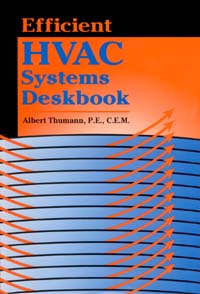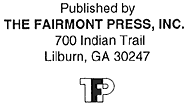Cover

| title | : | Efficient HVAC Systems Deskbook |
| author | : | Thumann, Albert. |
| publisher | : | The Fairmont Press |
| isbn10 | asin | : | 0881732613 |
| print isbn13 | : | 9780881732610 |
| ebook isbn13 | : | 9780585149127 |
| language | : | English |
| subject | Heating, Ventilation, Air conditioning. |
| publication date | : | 1997 |
| lcc | : | TH7015.T48 1997eb |
| ddc | : | 697 |
| subject | : | Heating, Ventilation, Air conditioning. |
Page i
Efficient HVAC Systems Deskbook
Page ii
This page intentionally left blank.
Page iii
Efficient HVAC Systems Deskbook
Albert Thumann, P.E., C.E.M.

Page iv
Library of Congress Cataloging-in-Publication Data
Thumann, Albert.
Efficient HVAC systems deskbook / Albert Thumann.
p. cm.
Includes index.
ISBN 0-88173-261-3
1. Heating. 2. Ventilation. 3. Air conditioning. I. Title.
TH7015.T48 1997 697--dc21 97-7758
CIP
Efficient HVAC Systems Deskbook By Albert Thumann.
1997 by The Fairmont Press, Inc. All rights reserved. No part of this publication may be reproduced or transmitted in any form or by any means, electronic or mechanical, including photocopy, recording, or any information storage and retrieval system, without permission in writing from the publisher.
Published by The Fairmont Press, Inc.
700 Indian Trail
Lilburn, GA 30247
Printed in the United States of America
10 9 8 7 6 5 4 3 2 1
ISBN 0-88173-261-3 FP
ISBN 0-13-760158-1 PH
While every effort is made to provide dependable information, the publisher, authors, and editors cannot be held responsible for any errors or omissions.
Distributed by Prentice Hall PTR
Prentice-Hall, Inc.
A Simon & Schuster Company
Upper Saddle River, NJ 07458
Prentice-Hall International (UK) Limited, London
Prentice-Hall of Australia Pty. Limited, Sydney
Prentice-Hall Canada Inc., Toronto
Prentice-Hall Hispanoamericana, S.A., Mexico
Prentice-Hall of India Private Limited, New Delhi
Prentice-Hall of Japan, Inc., Tokyo
Simon & Schuster Asia Pte. Ltd., Singapore
Editora Prentice-Hall do Brasil, Ltda., Rio de Janeiro
Page v
Table of Contents
Section I Fundamentals of HVAC Systems |
Chapter 1 Heating, Ventilating, Air Conditioning and Building Systems Fundamentals | |
Section II Indoor Air Quality Improvement |
Chapter 2 Energy-Efficient Strategies for Improved Dehumidification | |
Chapter 3 Ventilation or Filtration? The Use of Gas-Phase Air Filtration for Compliance with ASHRAE Standard 62 | |
Chapter 4 Improved Building Operation through the Use of Continuous Multi-Point Monitoring of Carbon Dioxide and Dew Point | |
Chapter 5 Practical Approaches for Health Care: Indoor Air Quality Management | |
Chapter 6 Ventilation Assessment of an Infectious Disease Ward Housing TB Patients | |
Chapter 7 Tuberculosis Infection Control Strategy in a Biosafety Level 3 Laboratory | |
Section III Chillers |
Chapter 8 Chillers and Refrigerants | |
Chapter 9 Central Plant Measurement and Diagnostics | |
Chapter 10 Industrial Central Chiller Facility Upgrade | |
Section IV Natural Gas Heating and Cooling |
Chapter 11 HVAC Technology and Trends: A Global Review | |
Chapter 12 Absorption Chillers | |
Chapter 13 Case Study: Direct-Fired Gas Adsorption System | |
Chapter 14 Desiccants: Benefits for the Second Century of Air Conditioning | |
Chapter 15 Case Study: Natural Gas Technologies at Kennedy Space Center | |
Chapter 16 Field Monitoring and Evaluation of a Residential Gas-Engine-Driven Heat Pump | |
Page vi
Section V Geothermal Heating and Cooling Systems |
Chapter 17 Geothermal Heating and Cooling Markets | |
Chapter 18 Case Study: Geothermal at Great Bridge Middle School | |
Section VI Thermal Energy Storage |
Chapter 19 The Effect of Real-Time Pricing (RTP) on Thermal Energy Storage Systems (TES) | |
Index | |
Page vii
Acknowledgments
The information contained in this book has been presented by a wide variety of authors at the World Energy Engineering Congress and the International Energy & Environmental Congress sponsored by the Association of Energy Engineers. Appreciation is expressed to all those who have contributed their expertise to this volume.
Page viii
This page intentionally left blank.
Page 1
Section I
Fundamentals of HVAC Systems
Page 2
This page intentionally left blank.
Page 3
Chapter 1
Heating, Ventilating, Air Conditioning and Building Systems Fundamentals.
This chapter will review the basics of heating, ventilating and air conditioning (HVAC) and buildings as related to energy engineering.
DEGREE DAYS
Degree days are the summation of the product of the difference in temperature (T) between the average outdoor and hypothetical average indoor temperatures (65F), and the number of days (t) the outdoor temperature is below 65F. Therefore:

Degree days divided by the total number of days on which degree days were accumulated will yield an average T for the season, based on an assumed indoor temperature of 65F. To find the average outdoor temperature of the season, this figure must be subtracted from 65F.
Example Problem 1-1
If there are 6,750 degree days recorded over a heating season of 270 days, what is the mean outdoor temperature for that season?
Answer

The average outdoor temperature can now be found, since
Page 4

Next page








